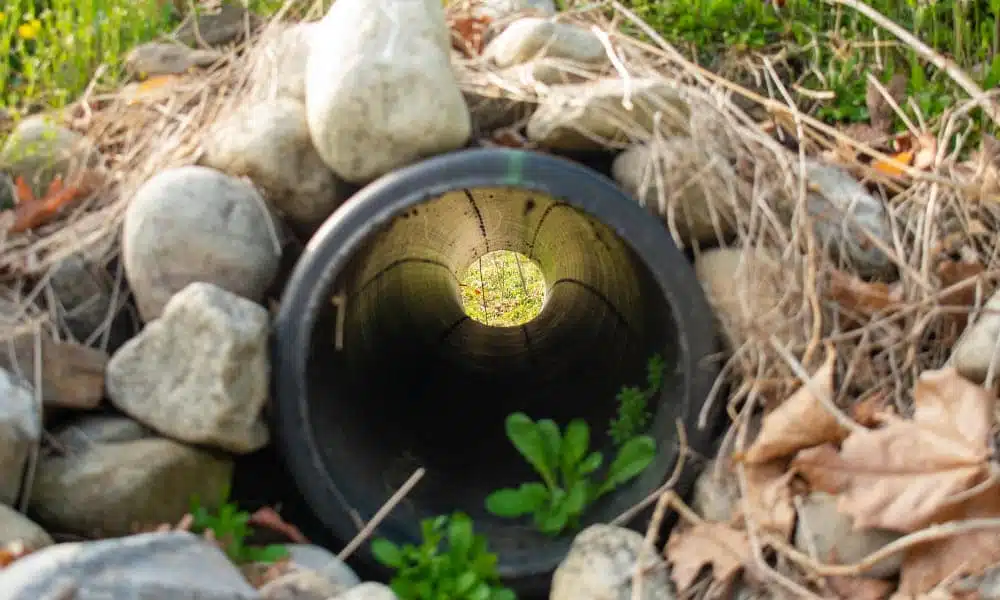French drains are among the best water management solutions anyone could install and one of the many options for basement drainage systems. These sturdy additions are designed to work in tandem with the water’s natural downhill flow, thus helping property owners tackle the many risks of not mitigating water damage.
French drains can be as attractive as they are practical, and they’re often a front-line defense for a property’s foundation, basement, and even the health and well-being of its residents. This guide will explain how French drains operate, the many benefits they can provide, and some common errors associated with their installation.
How Do French Drains Work?
The French drain cost and dimension ultimately depend on the site. These sloped trenches can be two feet deep (known as shallow drains) or deeper (footing drains). They are about a foot wide and usually perform more optimally when the higher property is on a slope. A quality team can slope even the most challenging drain, so it becomes an asset.
– The Basic Design
French drain systems are typically installed in underground trenches dug around the property’s perimeter. The channel itself slopes slightly so it can guide water away more effectively. The surface water then passes into the underground trench to be redirected away from the property.
– Inside a French Drain
The trench is filled with gravel and a PVC or drain pipe, which can be a perforated pipe or slotted design. The builder adds two layers of permeable fabric: one in the trench as it’s dug to prevent intrusion by soil and roots and again on top before topsoil replacement. Gravel on the surface and inside the drain acts like a sieve by straining debris while letting the liquid through.
– Deep Installation Means Better Drainage
French drainage systems don’t just help fight the dangers of surface water. Their subsurface installation also helps siphon any excess water from the deeper earth, which otherwise would remain trapped and possibly lead to soil erosion and wider structural instability.
French drain installation offers bonuses beyond the practical. Working with the right contractor can help you create a visually appealing, financially rewarding drainage solution that will protect the property for years to come and create a more attractive prospect for future buyers at resale.
What Are The Top 5 Benefits of French Drain Installation?

Few residential or commercial investments have the potential ROI of well-designed drainage. The sooner they are installed, the quicker they can help homeowners and businesses take more effective water management steps. Consider these benefits:
1. You Create a Stronger Foundation
Water can wreak havoc in and around a building’s foundation in multiple ways. Excess water can weaken or displace surrounding soil or seep directly through foundation cracks to compromise structural integrity. This may even necessitate the installation of basement drainage systems sooner than anticipated. French drain basement installation helps redirect water away from foundations to prevent this from happening. Remember that a basement French drain installation may not be a one-time cost – you may need to have the drain cleaned or maintained periodically to ensure its effectiveness.
2. French Drains Are Tough
Due to their subsurface operation, these designs must be more durable than other drainage options. Their underground design means French drains are subject to hydrostatic pressure, which is exerted by water through the force of gravity. The more durable a drain is, then, the more reliably it will perform.
3. Practical Power Meets Aesthetics
French drains get the job done without turning your property into an eyesore. The notion of digging a ditch may cause some apprehension, but once the drain is complete, it can be an eye-catching surface addition that does all its dirty work under the surface. Gravel comes in many shapes, sizes, and colors that can blend beautifully with the surrounding space.
4. Ease of Installation
Installing French drains are among the quickest and most economical drainage solutions. This is especially true if their installation doesn’t require disturbing any existing exterior structures.
5. You Can Decide Where the Water Goes
These designs give residential and commercial customers the choice of where redirected water ends up (within zoning regulations, of course). Builders can lay pipes to deposit water into a drainage ditch, for example, or perhaps into the street or a lower-lying area on the property.
A good drainage team will ensure you enjoy all the benefits of French drain installation and none of the drawbacks. Going it alone or taking just any contractor’s claims at face value can have the opposite effect and leave you with even more problems.
Some Common Pitfalls Connected With French Drains
The relative ease of installing a French drain doesn’t mean it’s something anyone can do. DIY diggers may find themselves in a hole, and sometimes you can’t even trust drainage teams to do it right. Here are a few things to be wary of:
- Digging underground carries the risk of striking utility lines and conduits, which could result in electrocution, compromising a gas main, or losing power to you and your neighbors.
- French drains can become clogged without regular maintenance, which turns them into another water management liability.
- Permits may be required to carry out this work. Any property owner or contractor who goes ahead without one puts people, property, and the project at physical and financial risk.
- Sloping should be at least 1% in drains that rely solely on gravity, or water won’t go anywhere.
- Properties situated at the bottom of a slope will have a harder time reaping the benefits of a French drain. Installation of a sump pump may be necessary in these cases.
- Redirecting water is a sensitive matter. Local authorities and neighboring property owners must be considered and consulted to ensure your drainage doesn’t negatively impact the surrounding area.
Property owners should always consult with a team that appreciates the mechanics and aesthetics of drainage. Adding a French drain is a great way to capitalize on both, but it’s only worth your time and investment if it fits your site and doesn’t cause any further issues. Skip the risks and get straight to the perks by selecting a contractor you can trust.
Contact an Expert With Any Drainage Questions
French drains can help protect properties, large or small, residential or commercial. They can also become money pits and danger zones if they’re not properly designed and laid.
The basement waterproofing pros at LUX Foundation Solutions have over 25 years of experience that lets us engineer the best drainage solution for your needs. This may be a French drain or any of several other designs we can build on schedule and on budget. Contact our team today to speak with an expert.
